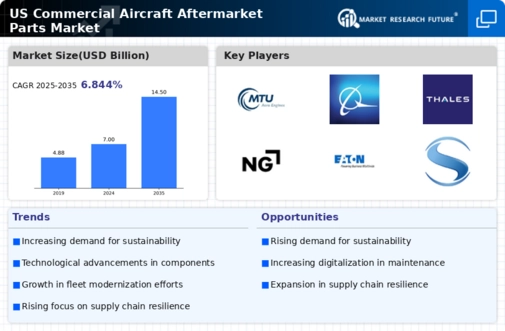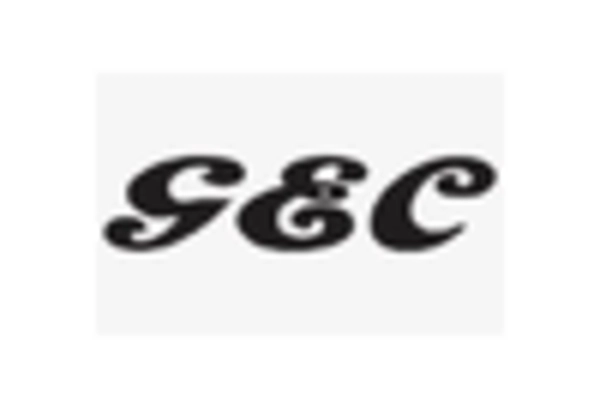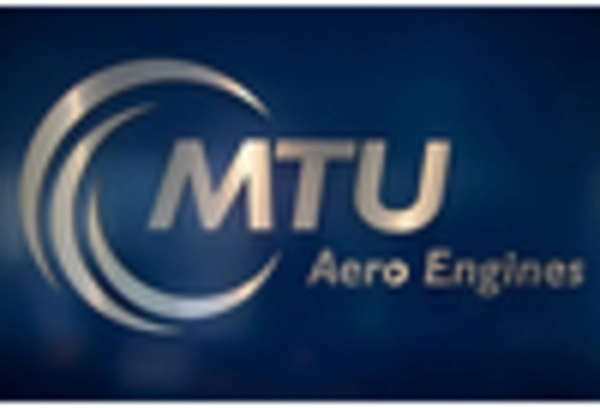Increasing Fleet Size
The commercial aircraft-aftermarket-parts market is experiencing growth due to the increasing size of the aircraft fleet in the US. As airlines expand their operations and add new aircraft to their fleets, the demand for aftermarket parts rises correspondingly. According to the Federal Aviation Administration (FAA), the US commercial fleet is projected to grow by approximately 3.5% annually over the next decade. This growth necessitates a steady supply of replacement parts and components, thereby driving the aftermarket sector. Additionally, older aircraft require more frequent maintenance and parts replacement, further contributing to the demand for aftermarket solutions. As airlines seek to optimize operational efficiency, the commercial aircraft-aftermarket-parts market is likely to benefit from this trend, as operators look for reliable sources of high-quality parts to ensure safety and performance.
Emerging Market Players
The commercial aircraft-aftermarket-parts market is witnessing the emergence of new players, which is reshaping the competitive landscape. These new entrants often bring innovative solutions and competitive pricing, challenging established suppliers. The presence of these emerging companies can stimulate market growth by providing airlines with more options for sourcing parts. Additionally, the entry of new players may lead to advancements in product offerings, as they seek to differentiate themselves through technology and service quality. This dynamic environment encourages existing suppliers to enhance their offerings and improve customer service, ultimately benefiting the commercial aircraft-aftermarket-parts market. As competition intensifies, airlines may find themselves with a broader range of choices, which could lead to cost savings and improved operational efficiency.
Rising Air Travel Demand
The commercial aircraft-aftermarket-parts market is poised for growth due to the rising demand for air travel in the US. As consumer preferences shift towards air travel for both business and leisure, airlines are expanding their routes and increasing flight frequencies. The Bureau of Transportation Statistics reports that passenger enplanements have seen a steady increase, with projections indicating a growth rate of around 4% annually. This surge in air travel necessitates a larger number of operational aircraft, which in turn drives the need for aftermarket parts. Airlines must ensure that their fleets are well-maintained and equipped with the necessary components to meet this growing demand. Consequently, the commercial aircraft-aftermarket-parts market is likely to experience heightened activity as airlines seek to maintain their competitive edge in a rapidly evolving industry.
Technological Integration
The integration of advanced technologies in aircraft maintenance and repair is significantly influencing the commercial aircraft-aftermarket-parts market. Innovations such as predictive maintenance, data analytics, and digital twin technology are enhancing the efficiency of maintenance operations. These technologies allow airlines to anticipate part failures and schedule maintenance proactively, which can reduce downtime and operational costs. The FAA has noted that the adoption of such technologies can lead to a reduction in maintenance costs by up to 20%. As airlines increasingly rely on data-driven decision-making, the demand for aftermarket parts that are compatible with these technologies is expected to rise. This trend indicates a shift towards more sophisticated maintenance practices, which could reshape the landscape of the commercial aircraft-aftermarket-parts market.
Focus on Safety and Compliance
Safety and regulatory compliance remain paramount in the commercial aircraft-aftermarket-parts market. The FAA enforces stringent regulations regarding aircraft maintenance and parts replacement, which compels airlines to adhere to high safety standards. As a result, there is a consistent demand for certified aftermarket parts that meet these regulatory requirements. The emphasis on safety has led to an increase in inspections and maintenance checks, further driving the need for reliable aftermarket solutions. Airlines are increasingly investing in quality parts to ensure compliance with safety regulations, which can mitigate risks associated with aircraft operations. This focus on safety not only enhances operational reliability but also fosters consumer confidence in air travel, thereby supporting the growth of the commercial aircraft-aftermarket-parts market.

















Leave a Comment